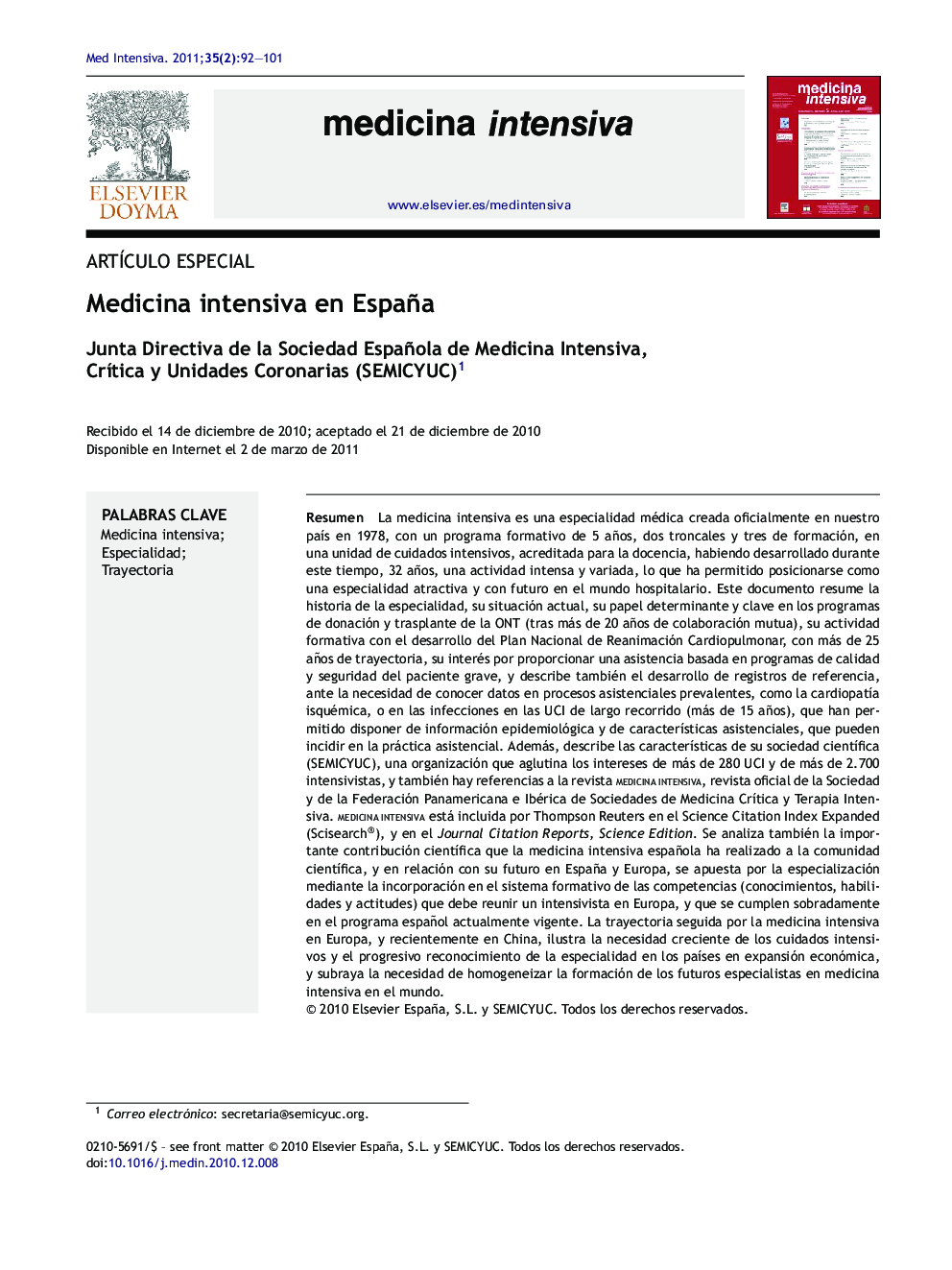| Article ID | Journal | Published Year | Pages | File Type |
|---|---|---|---|---|
| 3113483 | Medicina Intensiva | 2011 | 10 Pages |
ResumenLa medicina intensiva es una especialidad médica creada oficialmente en nuestro país en 1978, con un programa formativo de 5 años, dos troncales y tres de formación, en una unidad de cuidados intensivos, acreditada para la docencia, habiendo desarrollado durante este tiempo, 32 años, una actividad intensa y variada, lo que ha permitido posicionarse como una especialidad atractiva y con futuro en el mundo hospitalario. Este documento resume la historia de la especialidad, su situación actual, su papel determinante y clave en los programas de donación y trasplante de la ONT (tras más de 20 años de colaboración mutua), su actividad formativa con el desarrollo del Plan Nacional de Reanimación Cardiopulmonar, con más de 25 años de trayectoria, su interés por proporcionar una asistencia basada en programas de calidad y seguridad del paciente grave, y describe también el desarrollo de registros de referencia, ante la necesidad de conocer datos en procesos asistenciales prevalentes, como la cardiopatía isquémica, o en las infecciones en las UCI de largo recorrido (más de 15 años), que han permitido disponer de información epidemiológica y de características asistenciales, que pueden incidir en la práctica asistencial. Además, describe las características de su sociedad científica (SEMICYUC), una organización que aglutina los intereses de más de 280 UCI y de más de 2.700 intensivistas, y también hay referencias a la revista Medicina Intensiva, revista oficial de la Sociedad y de la Federación Panamericana e Ibérica de Sociedades de Medicina Crítica y Terapia Intensiva. Medicina Intensiva está incluida por Thompson Reuters en el Science Citation Index Expanded (Scisearch®), y en el Journal Citation Reports, Science Edition. Se analiza también la importante contribución científica que la medicina intensiva española ha realizado a la comunidad científica, y en relación con su futuro en España y Europa, se apuesta por la especialización mediante la incorporación en el sistema formativo de las competencias (conocimientos, habilidades y actitudes) que debe reunir un intensivista en Europa, y que se cumplen sobradamente en el programa español actualmente vigente. La trayectoria seguida por la medicina intensiva en Europa, y recientemente en China, ilustra la necesidad creciente de los cuidados intensivos y el progresivo reconocimiento de la especialidad en los países en expansión económica, y subraya la necesidad de homogeneizar la formación de los futuros especialistas en medicina intensiva en el mundo.
Intensive care medicine is a medical specialty that was officially established in our country in 1978, with a 5-year training program including two years of common core training followed by three years of specific training in an intensive care unit accredited for training. During this 32-year period, intensive care medicine has carried out an intense and varied activity, which has allowed its positioning as an attractive and with future specialty in the hospital setting. This document summarizes the history of the specialty, its current situation, the key role played in the programs of organ donation and transplantation of the National Transplant Organization (after more than 20 years of mutual collaboration), its training activities with the development of the National Plan of Cardiopulmonary Resuscitation, with a trajectory of more than 25 years, its interest in providing care based on quality and safety programs for the severely ill patient. It also describes the development of reference registries due to the need for reliable data on the care process for the most prevalent diseases, such as ischemic heart disease or ICU-acquired infections, based on long-term experience (more than 15 years), which results in the availability of epidemiological information and characteristics of care that may affect the practical patient's care. Moreover, features of its scientific society (SEMICYUC) are reported, an organization that agglutinates the interests of more than 280 ICUs and more than 2700 intensivists, with reference to the journal Medicina Intensiva, the official journal of the society and the Panamerican and Iberian Federation of Critical Medicine and Intensive Care Societies. Medicina Intensiva is indexed in the Thompson Reuters products of Science Citation Index Expanded (Scisearch®) and Journal Citation Reports, Science Edition. The important contribution of the Spanish intensive care medicine to the scientific community is also analyzed, and in relation to the future of intensive care medicine in Spain and in Europe, recommendations are made towards specialization in intensive care medicine incorporating in the training program those competences (knowledge, skills and attitudes) that should be present an intensivist in Europe and that are extensively fulfilled by the current Spanish training program. The trajectory followed by intensive care medicine in Europe and recently in China, shows the increasing need of intensive care and the progressive recognition of the specialty in economically growing countries, and emphasizes the need of homogenization in the training of future specialists in intensive care medicine globally.
